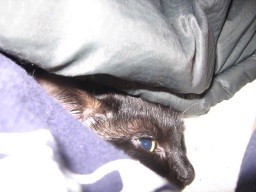MORNING:
~ Wake up, meow softly so my owner will let me out into the tent with her so I can burrow under the sleeping bag:

~ 'Mom' gets up and puts me in the big wire pen. I use the litter box (and I've really got to go since 'mom' made me hold it all night!) and groom myself while waiting for 'mom' to get back from her walk with the dog.
Good morning!
MID-MORNING:
~ First exercise session on the zipline while 'mom' cleans my litter box and sets up my kennel complex. Sometimes people will play with me using a carpet mouse attached to a fishing pole (a wonderful idea--cast the mouse wherever you want and reel it in). Sometimes I also explore, chase bugs, stalk the chipmunks and blackbirds, roll in the dirt, and sun myself.

Exploring in the woods
Here I am playing with my little
mouse on a log.
Sunning myself on the log
Mom interrupting my dirtbath...
Breakfast morsels of beef with a
couple kitty treats for being such a good camping cat.
LATE MORNING and EARLY AFTERNOON:
~ 'Mom' returns me to the kennel before they go away for the afternoon, so I take a nap and wait for 'mom' to get back from the lake.
LATE AFTERNOON and EARLY EVENING:
~ Another exercise session on the zipline while everyone relaxes. Now is the time to chase lizards and climb the trees:
Stalking the lizards
EVENING and LATE EVENING:
~ Night is falling but now is the time to eat since the yellow jackets are not around much.
~ It gets really dark and quiet, and then it is time for bed. 'Mom' puts me in the tent and after cleaning myself briefly I crawl into my kennel and fall asleep until morning.
Dinner tonight is a chicken wing with a side of pork (which I ate already)

